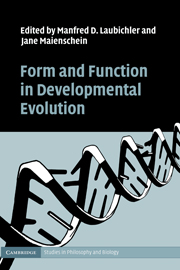Book contents
- Frontmatter
- Contents
- List of figures
- List of tables
- List of contributors
- List of journal abbreviations
- 1 Introduction
- 2 Form and function in Evo Devo: historical and conceptual reflections
- 3 Deducing plant function from organic form: challenges and pitfalls
- 4 Evolution in the light of embryos: seeking the origins of novelties in ontogeny
- 5 A focus on both form and function in examining selection versus constraint
- 6 Innovation and diversity in functional morphology
- 7 The developmental evolution of avian digit homology: an update
- 8 Functional analysis and character transformation
- 9 The nature of constraints
- 10 Toward a mechanistic Evo Devo
- Index
- References
4 - Evolution in the light of embryos: seeking the origins of novelties in ontogeny
Published online by Cambridge University Press: 28 June 2009
- Frontmatter
- Contents
- List of figures
- List of tables
- List of contributors
- List of journal abbreviations
- 1 Introduction
- 2 Form and function in Evo Devo: historical and conceptual reflections
- 3 Deducing plant function from organic form: challenges and pitfalls
- 4 Evolution in the light of embryos: seeking the origins of novelties in ontogeny
- 5 A focus on both form and function in examining selection versus constraint
- 6 Innovation and diversity in functional morphology
- 7 The developmental evolution of avian digit homology: an update
- 8 Functional analysis and character transformation
- 9 The nature of constraints
- 10 Toward a mechanistic Evo Devo
- Index
- References
Summary
ROLES FOR DEVELOPMENT IN EVOLUTION
In the later part of the nineteenth century, it became evident that there was a hereditary connection between the development of living organisms and their evolutionary ancestors (Amundson 2005). This connection was given mechanistic underpinnings by Müller (1869), and was elaborated and formalized by Ernst Haeckel in his recapitulation theory, in which he attempted to link the mechanisms of evolution of descendants to the development of their ancestors by means of addition of new terminal stages, combined with the shortening of life stages inherited from the ancestors. The result, according to Haeckel, was that living forms in their development literally recapitulate the adult forms of their ancestors in a condensed sequence. This was the most influential theory of the late nineteenth century, linking evolution causally to both Lamarkian heredity and ontogeny (Gould 1977; Richardson and Keuck 2002). Although important in inspiring studies in comparative embryology, which were used in seeking phylogenetic information on remote ancestors, the hold of this theory on biologists weakened by the mid 1890s. Following Roux's influential lead, embryologists became interested in the mechanisms of developmental processes per se and abandoned Haeckel's phylogenetic program that offered little insight into how embryos develop. Haeckelian recapitulation as a mechanism was subsequently shown to be unfeasible with the rediscovery of Mendelian inheritance, which uprooted terminal addition from its theoretical foundations.
- Type
- Chapter
- Information
- Form and Function in Developmental Evolution , pp. 83 - 111Publisher: Cambridge University PressPrint publication year: 2009
References
- 7
- Cited by



